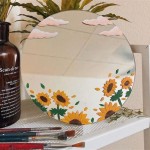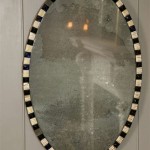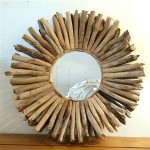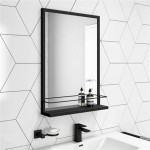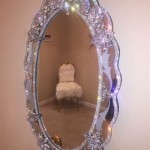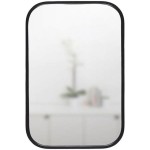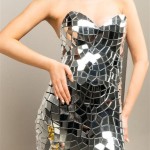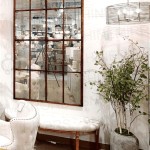Antique Looking Mirror Glass: A Guide to Achieving the Vintage Look
The allure of antique mirrors lies in their unique, aged appearance. This aged look, characterized by subtle imperfections and a distinctive patina, adds character and depth to any interior design. Replicating this antique aesthetic with modern methods offers an appealing alternative to sourcing and restoring genuine antique mirrors, which can be costly and challenging. This article explores various techniques and considerations involved in achieving an antique look in mirror glass.
Understanding the Characteristics of Antique Mirror Glass
Authentic antique mirrors possess several defining characteristics that contribute to their aged appearance. Recognizing these features helps in replicating the desired vintage aesthetic effectively:
- Foxing and Silvering Loss: Dark spots and patches, known as foxing, are a common sign of age, resulting from the deterioration of the silvering backing over time. This deterioration can also lead to areas where the silvering is completely lost, revealing the clear glass beneath.
- Distortion and Imperfections: Older manufacturing techniques often resulted in subtle waves or distortions in the glass surface. Tiny bubbles or imperfections within the glass itself are also common.
- Patina and Tarnish: The reflective surface of antique mirrors often develops a subtle tarnish or patina, which can vary in color from light gray to amber or even slightly purple, depending on the age and environmental exposure of the mirror.
Techniques for Creating an Antique Mirror Effect
Several methods can be employed to create an antique look on modern mirror glass. Each technique offers different levels of control and produces unique results:
- Chemical Aging: This technique involves applying specialized chemical solutions to the back of a mirror to induce the deterioration of the silvering. This creates a controlled aging effect, mimicking the appearance of foxing and silvering loss.
- Antiquing Paint: Applying specialized antiquing paints or glazes to the back of the mirror allows for creating various effects, from subtle tarnish to more pronounced age spots. This method offers greater control over the final appearance.
- Distressing Techniques: Lightly sanding or etching the glass surface can create minor imperfections and a slightly hazy look, reminiscent of older glass. This method requires careful execution to avoid excessive damage.
Choosing the Right Mirror Glass
The type of mirror glass used can also influence the final antique look. Different glass compositions and thicknesses can affect the way light interacts with the mirror and the overall aesthetic:
- Thickness: Thicker glass can enhance the illusion of age, particularly when combined with distressing techniques, as thicker glass is more common in antique mirrors.
- Color: While clear glass is standard, tinted glass options can add another layer of authenticity. Subtle tints of gray or amber can complement the aged look achieved through other techniques.
Application and Safety Considerations
When applying antiquing techniques, proper safety precautions are crucial. Working with chemicals or distressing glass requires adequate ventilation and protective gear, such as gloves and eye protection. Careful handling of the glass is essential to prevent breakage and injury.
Achieving Specific Antique Styles
Tailoring the antiquing process can create specific vintage styles:
- Victorian Style: This style often features heavy foxing and silvering loss, combined with a noticeable patina. Utilizing both chemical aging and antiquing paints can effectively achieve this look.
- Art Deco Style: A less distressed look is typical of this era, with subtle tarnish and minimal silvering loss. Focusing on antiquing paints and subtle distressing techniques can recreate this aesthetic.
- Mid-Century Modern: This style may incorporate clean lines with minimal aging, perhaps featuring a slight amber tint to the glass. Using tinted glass and subtle antiquing paints can produce this effect.
Considerations for Different Applications
The intended use of the antiqued mirror influences technique selection:
- Wall Mirrors: Larger wall mirrors provide ample surface area for showcasing intricate antiquing effects. Chemical aging, paint techniques, and distressing can be combined for a dramatic result.
- Furniture Accents: Smaller, framed mirrors intended for furniture accents may benefit from more subtle antiquing. Focusing on antiquing paints or a light chemical aging process can achieve a refined vintage look.
- Decorative Objects: For smaller decorative objects incorporating mirror glass, carefully applied antiquing paints offer the greatest control over the final appearance.
Maintaining the Antiqued Look
Proper care and cleaning methods are essential for preserving the antiqued finish. Using gentle cleaners and avoiding abrasive materials will help maintain the desired look over time. When cleaning mirrors treated with antiquing techniques, avoid excessive moisture, which could damage the aged effect.

Antique Mirror Glass Safety Replacements

Antique Mirrors Capital Glass

Antique Mirror Glass

Steel Framed Wall Mirror Antiqued Distressed With Subtle Black Frame Decorative W Handmade Antique Glass Nederland

Antique Mirror Glass Devlin In Design Specialist Decorators

Antique Mirror Tiles Glass Backsplash

Where To Find Antiqued Mirror September 2024 Your Guide

Glass Distressed Mirror Antique Usage Home At Rs 180 In Mumbai

Antique Mirror Glass Devlin In Design Specialist Decorators

Antique Mirror Glass Aged Distressed Foxed Tiles 40x40cm

